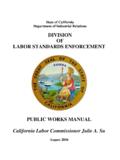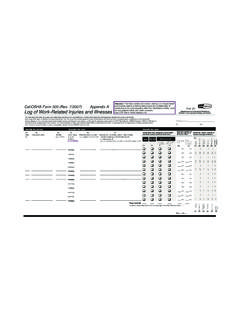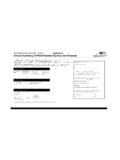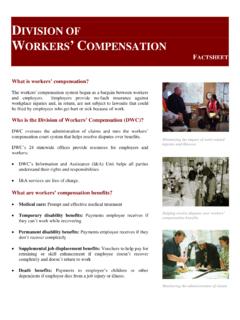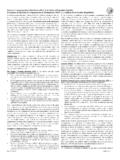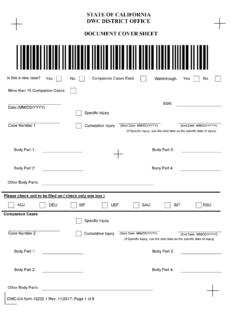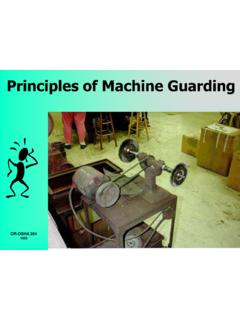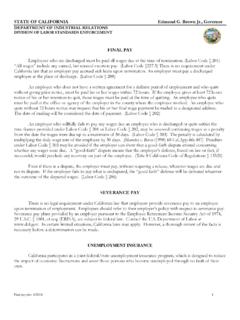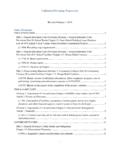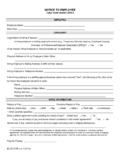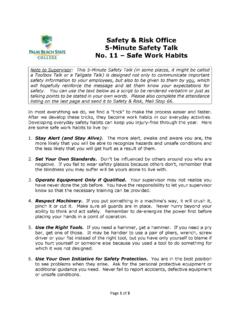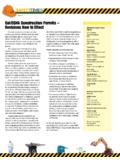Transcription of Tailgate/Toolbox Topics - dir.ca.gov
1 Jobsite tailgate and toolbox safety meetings are proven methods of preventing accidents, illnesses and on-the-job injuries. The safety meetings can be as brief as 10 or 15 minutes in length, and provide the opportunity to implement your Injury and Illness Prevention Program and improve the safety culture at your jobsite. tailgate or toolbox safety meetings help employees to recognize and eliminate jobsite hazards. Why Have tailgate safety Meetings? If you work in the tunneling and construction industries, tailgate safety meetings are required by Title 8, Sections 8406 and 1509 of the California Code of Regulations.
2 While tunneling and construction are the only industries that specifically require tailgate safety meetings, all California employers must have a safety program that includes employee training in safe work practices ( 3203). Tailgate/Toolbox safety meetings can be used to a ddress ac tual problems on the job or in the work area. The supervisors or foremen leading the meeting can draw on workers own real life experiences, and use those ex periences to remind all employees especially newer ones of the dangers of working with particular ki nds of machinery, tools, equipment and materials.
3 Tit le 8, Calif ornia Code of Regulations, Section 1509(e) states: Supervisory employees shall conduct " toolbox " or " tailgate " safety meetin gs, or equivalent, with their crews a t least every 10 working days to emphasize safety . What to Talk About? Talk about work practices, machinery, tools, equipment, materials, atti tudes and anything else that may cause or contribute to a work-related a ccident or illness. Keep the topic relevant to the job or tasks that workers perform. To identify safety meeting Topics that will help your employees perform their jobs in a safer and more effective manner, you should review: OSHA Log 300 records (work-related deaths, injuries, and illnesses that require more than first aid treatment).
4 Findings from safety inspections including corrective actions taken. Findings from accident investigations and near misses. Cal/OSHA safety Orders (Title 8) at: In addition to reviewing your records, look for potential safety hazards by carefully observing your workplace and employees' work activities. For example, if you notice that spills are not being cleaned up promptly, hold a tailgate safety meeting to discuss housekeeping policies. If an accident or a near-accident occurred at your jobsite, share the details and corrective actions during a tailgate safety meeting.
5 Try to answer the following questions at the meeting: what happened? Where did it happen? How can it be prevented from happening again? Encourage employees to suggest Topics to be discussed. Employees often know where the hazards are and can suggest corrective actions. An excellent source f or c onstruction related t opics is the publication Cal/OSHA Pocket Guide for the Construction Industry. Supervisors can c hoose individual sections o r Topics from this guide and tailor the information to the specific needs of their jobsites.
6 Supervisors can also use the tailgate safety Meeting Topics worksheet for selecting, tracking and recording the tailgate meeting Topics . How to Run an Effective Meeting 1. Hold the meeting at the jobsite, preferably where everyone can sit and relax. 2. Hold meetings at the start of a shift or after a break. 3. Choose the topic carefully. Topics should be about health and safety problems on the j ob. Research the pr oblem before the meeting. For issues with machinery, consult the manufacturer s operatio ns manual.
7 For handling toxic substances, get a copy of the safety Data Sheet (SDS). Your insurance carrier i s another valuable source of information. For Cal/OSHA s educational m aterials on worksite safety and healt h, please visit: 4. Supervisors should chose Topics that directly relate to their projects and job tasks, and remember to be prepared: Explain why the topic is timely and important. Familiarize yourself with the topic before discussing it. Know your company procedures/Code of Safe Practices.
8 Make a short list of key points you want to cover. Include relevant Cal/OSHA regulations and best practices. Pick from the Topics listed on the tailgate safety Meeting Topics , whenever possible. Determine if the safety meeting material will be presented or distributed 5. Keep the topic specific. Do not c hoose an overly broad topic. 6. Make it practical. Demonstrate: Safe work practices Proper use of tools and equipment Tailgate/Toolbox Topics Division of Occupational safety and Health Cal/OSHA Consultation Services Branch Setting Up a Tailgate/Toolbox safety Meeting November 2015 7.
9 Support employee participatio n by asking questions on work practices and encouraging discussion on the Topics . 8. Talk about personal experiences or have one of the crew tell a story about a near miss, an injury, or a workplace fatality. Personal stories and experiences can dramatically enhance safety messages. 9. Keep the meeting short - usually 10 to 15 minutes. 10. After the meeting, take the time to consider the following: Did the topic fit the jobsite? Did the crew participate? Did someone demonstrate safety equipment or safety practices?
10 Did the meeting lead to changes in work practices? 11. Evaluate the tailgate meeting s impact. Are employees clear on recognizing and correcting hazards? Ask questions, walk the jobsite and observe. 12. Document/record the meeting topic, date, who was in attendance and any actions taken such as recording safe work practices that employees can perform. Also note any other employer actions to be taken to ensure a safe workplace. Additional tailgate Meetings Resources Further assistance on general safety and health training in the workplace, resources for conducting effective tailgate meetings and training/meeting materials may be obtained from the organizations listed below: California Department of Industrial Relations Division of Occupational safety and Health (DOSH) Effective Workplace Training eTool Providing effective on-the-job training contributes greatly to a safer and more healthful work environment.
